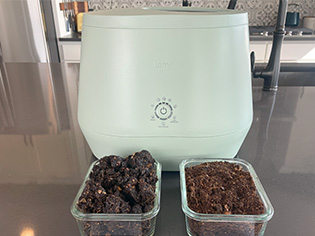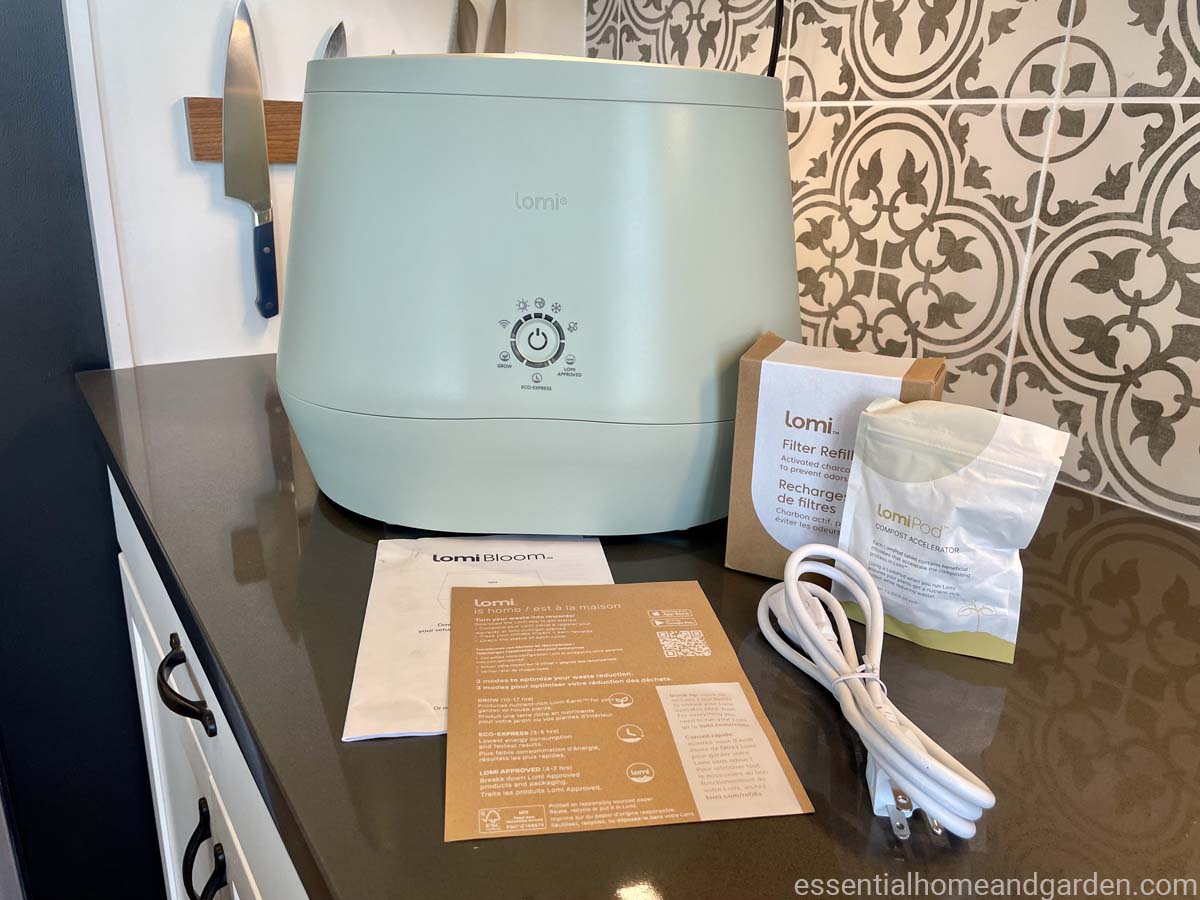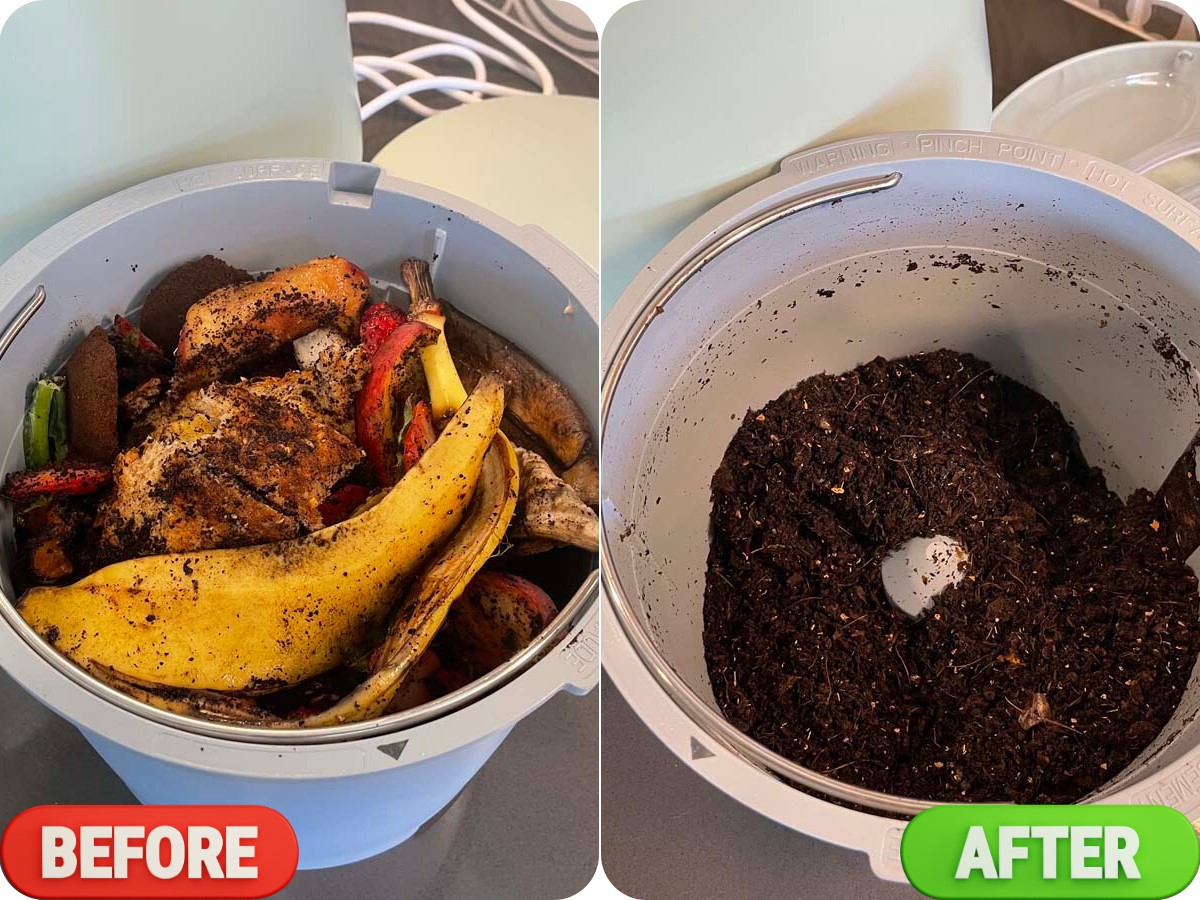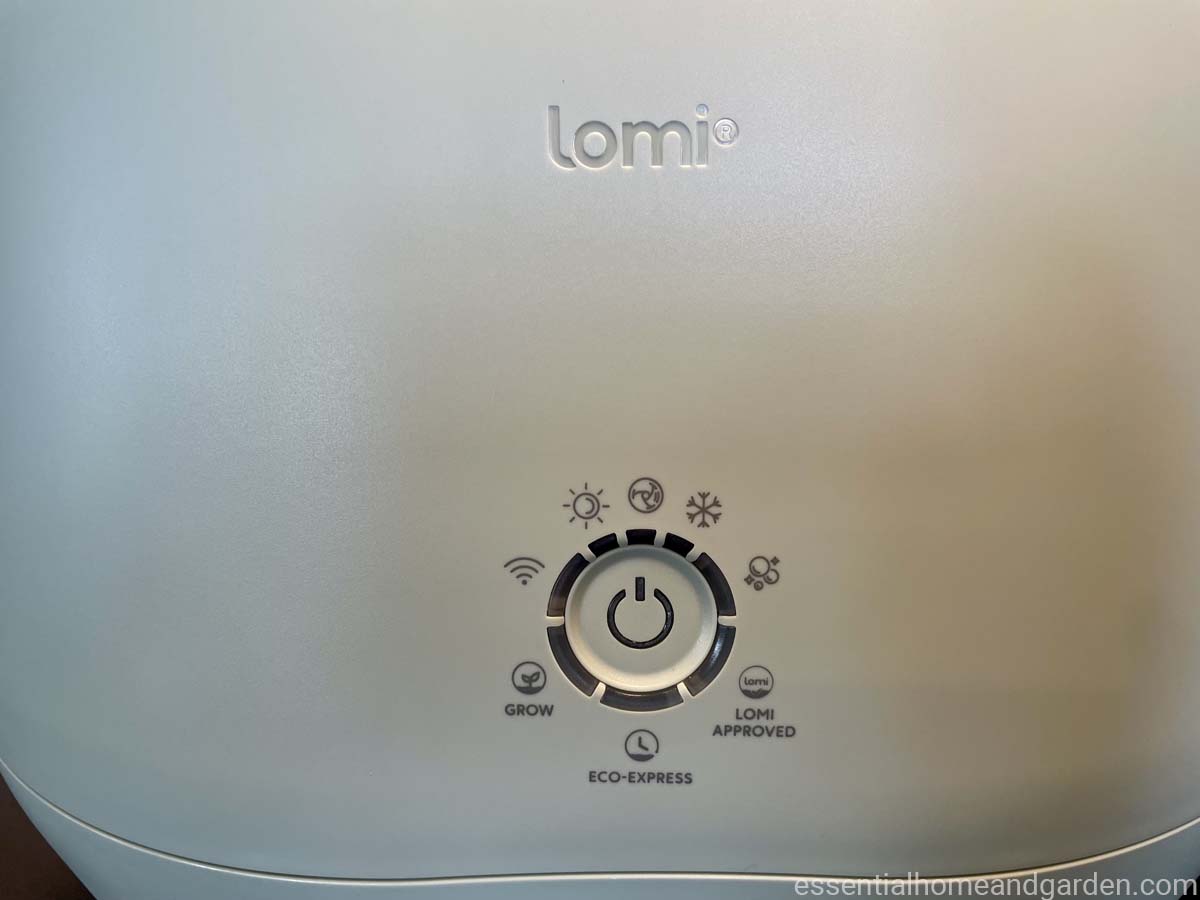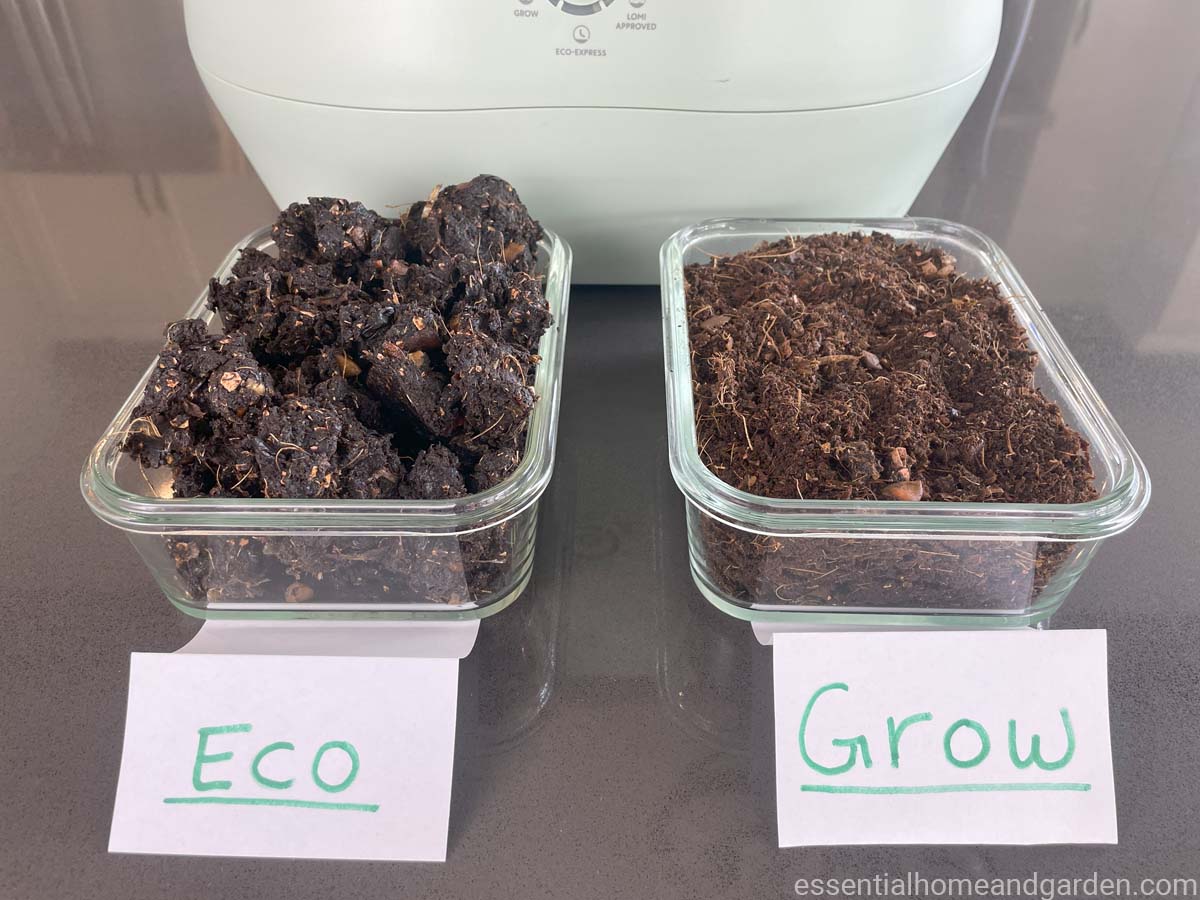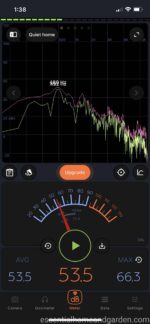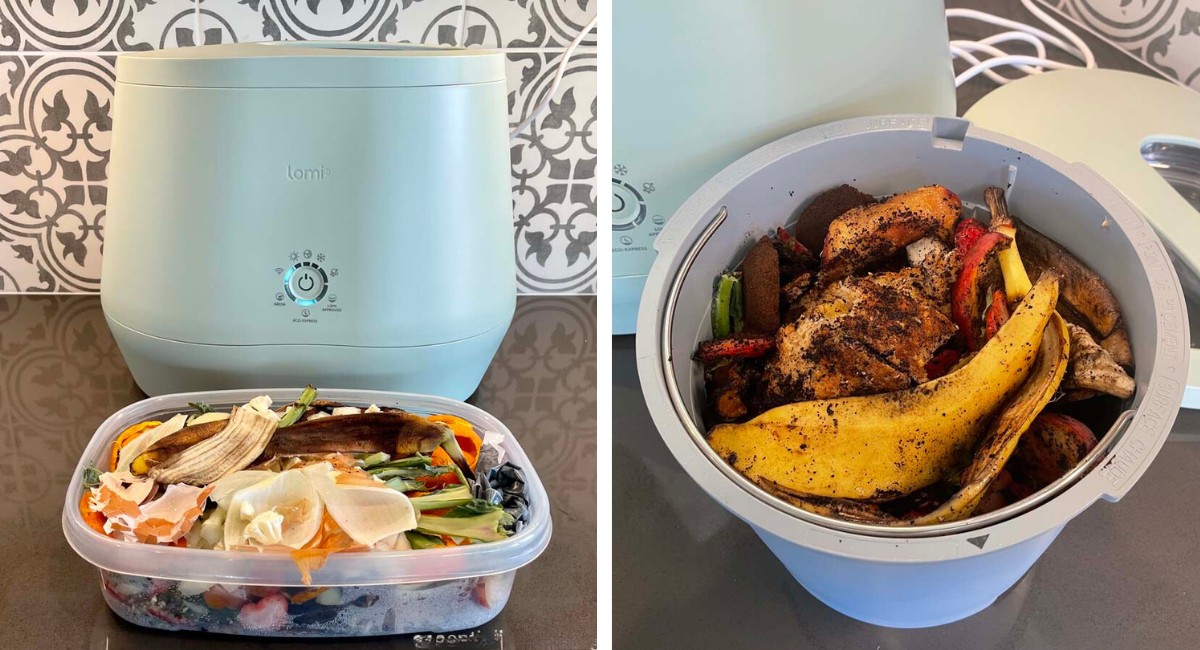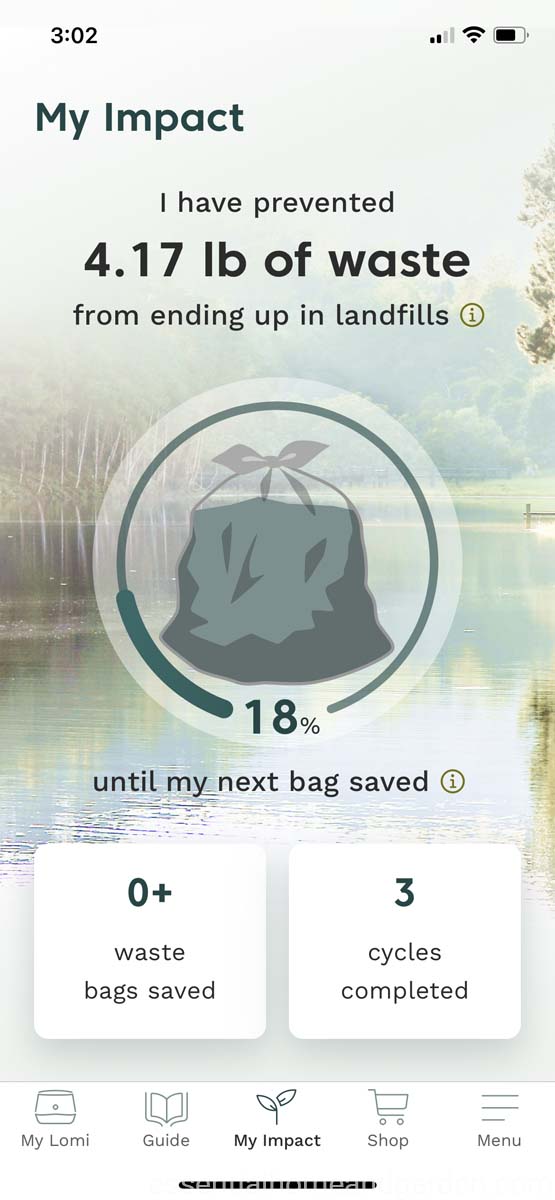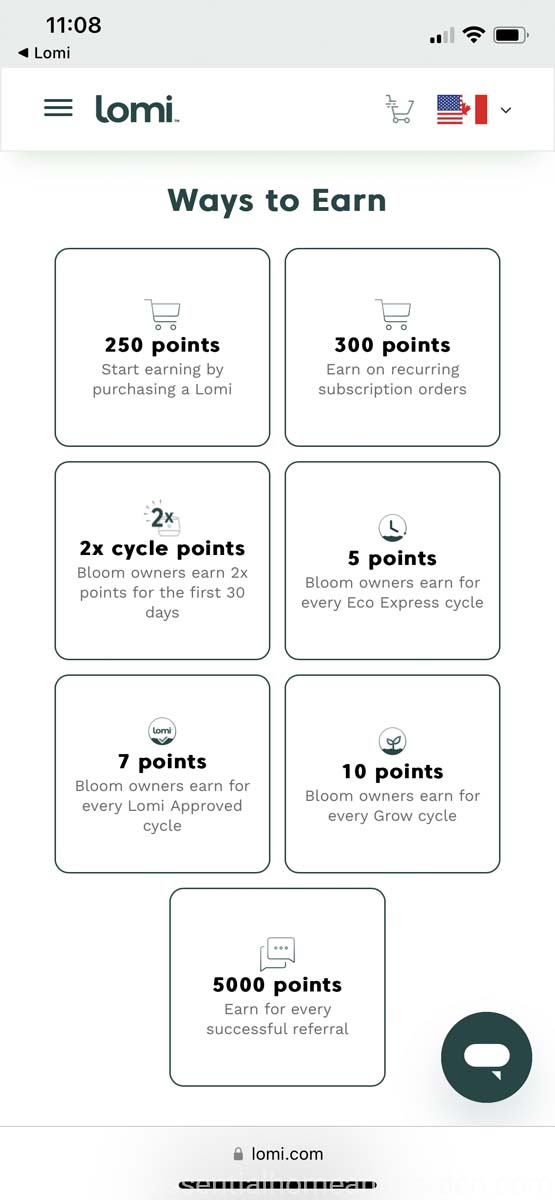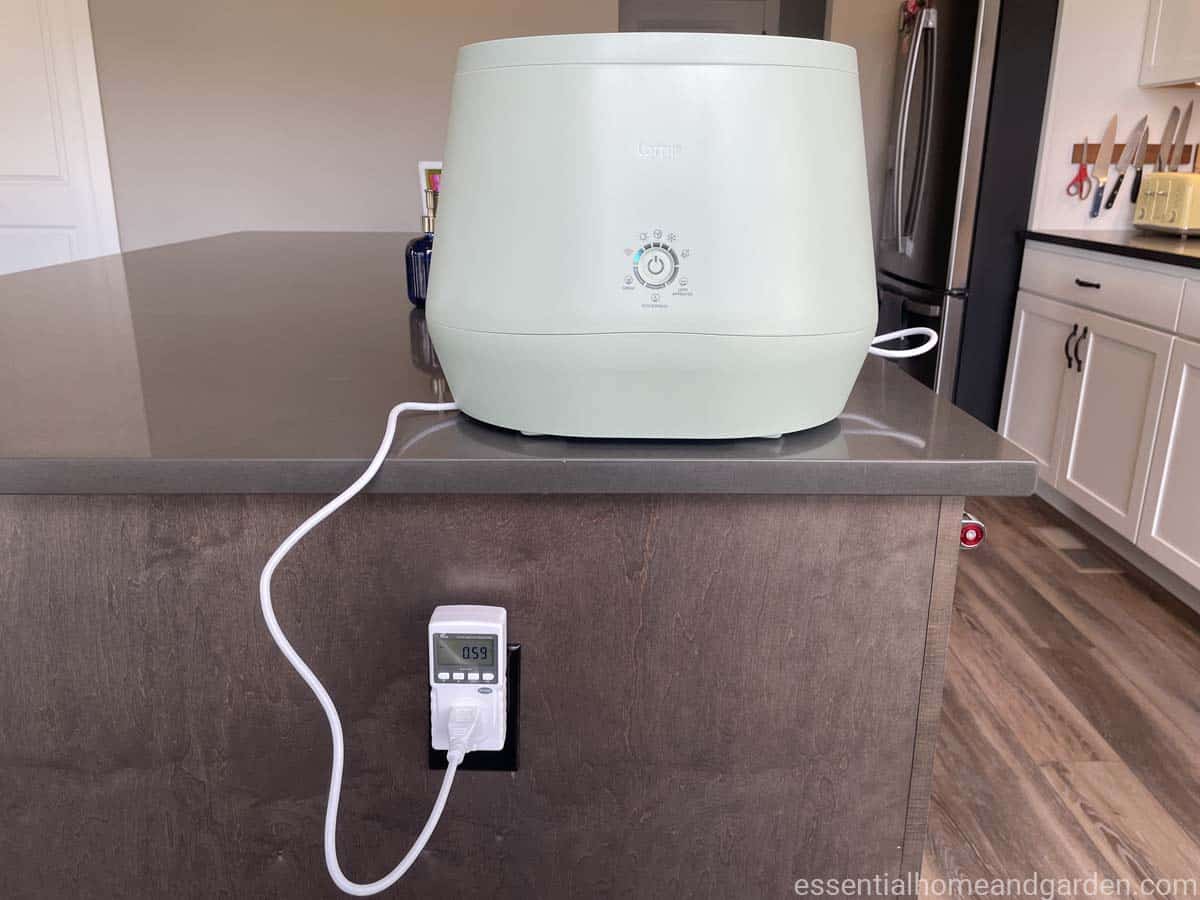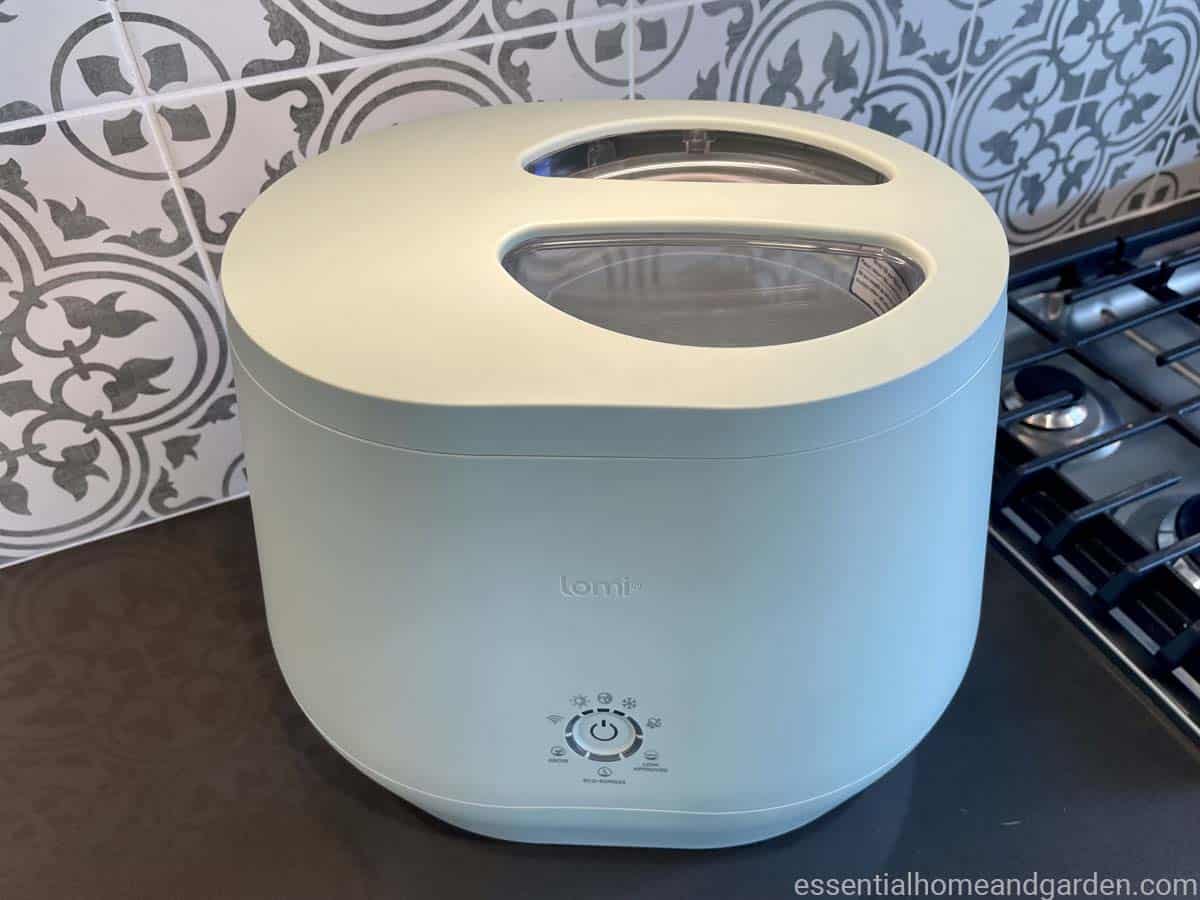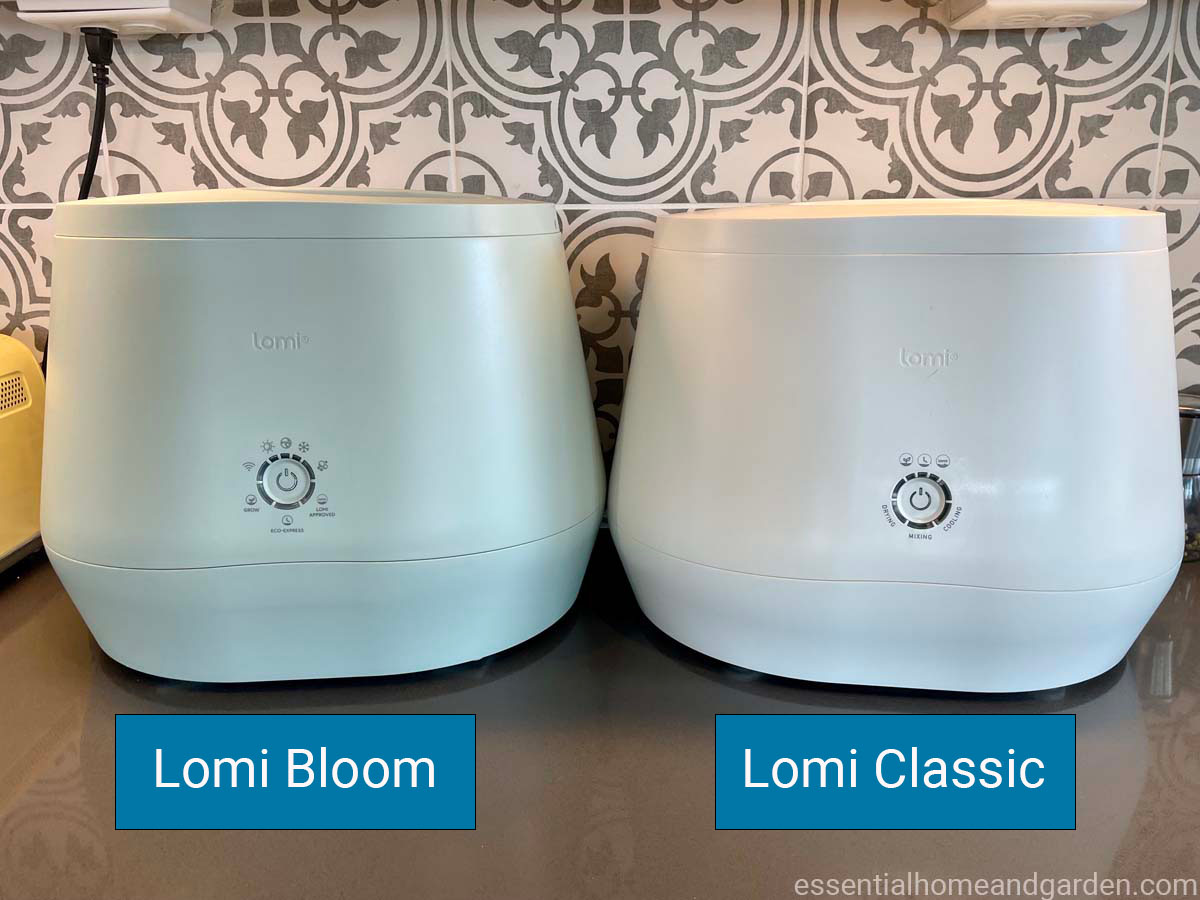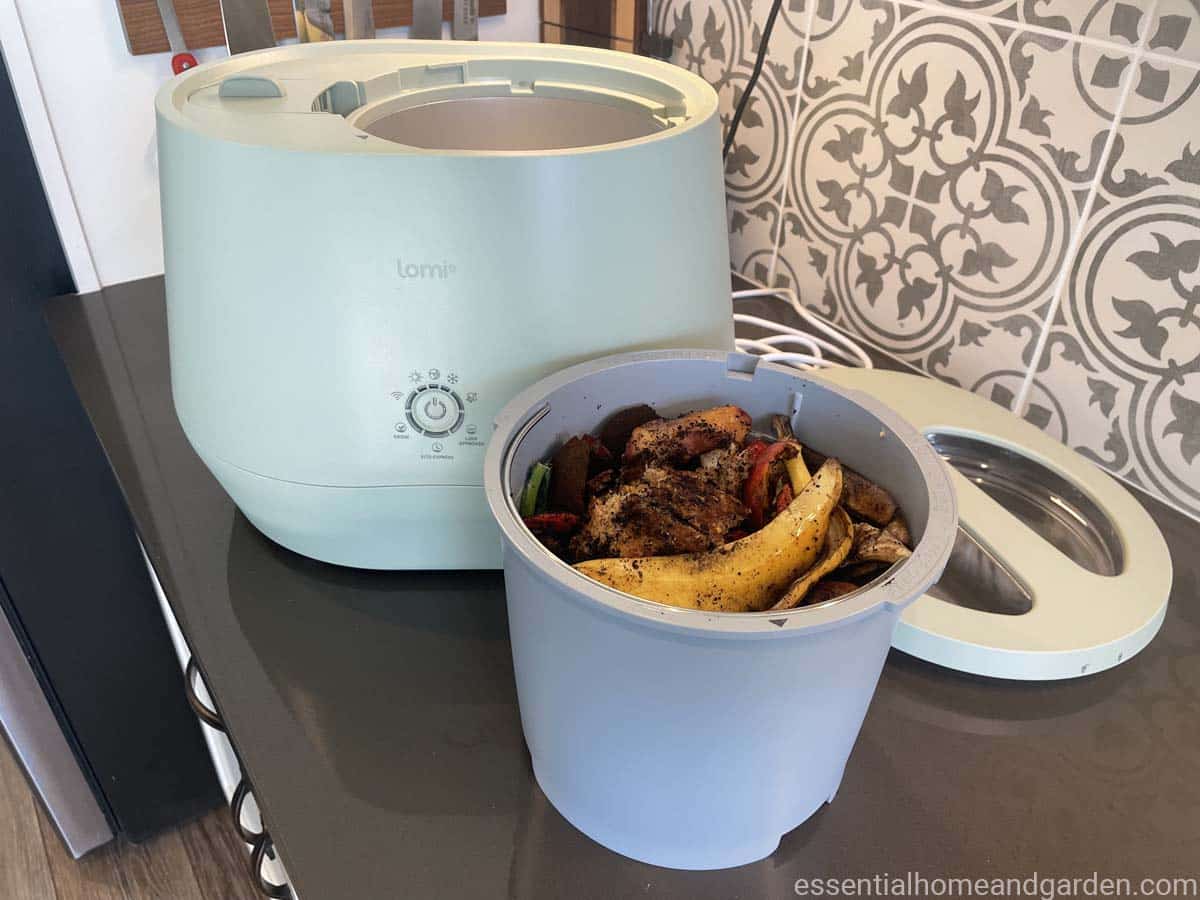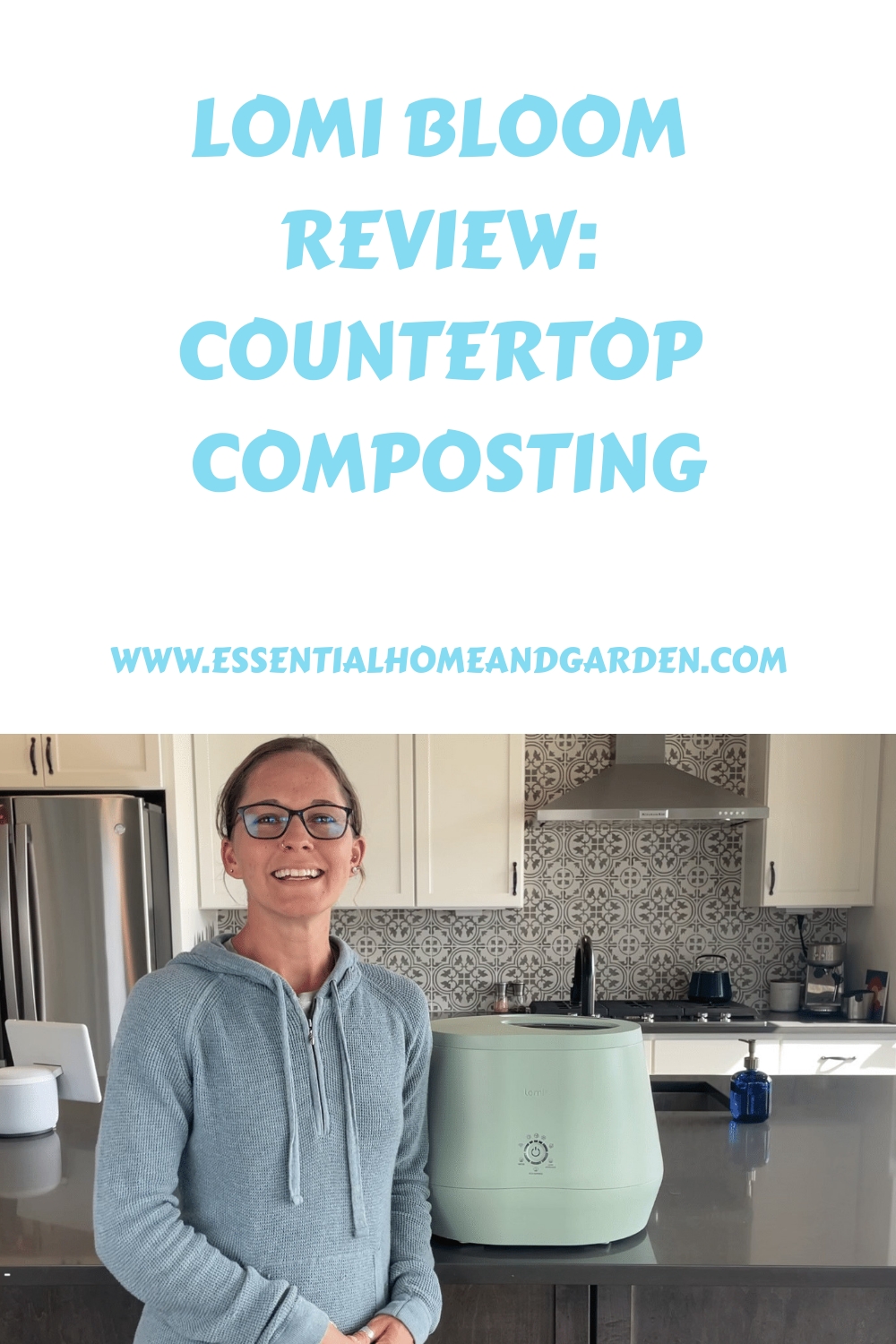Lomi Bloom
- Efficient composting process
- Versatile compost usage
- User-friendly
- Connected smart waste experience
Like its predecessor, Lomi Bloom has the power to turn just about any food scrap you create into precompost for a healthier garden. And it works wonders to reduce food waste and associated methane emissions for a healthier planet. Unlike its predecessor, this wifi-enabled smart Lomi also has some tricks to make your life easier.
But is it worth the extra money? That all depends on how often you plan to use it.
Who Should Buy It?
Lomi Bloom truly is an effective way to reduce your household waste by turning food into soil. If keeping food out of landfills and doing better for the planet is important to you, this product is worth it. This is especially true if you have a garden or other means to put this precompost to use.
Who Shouldn’t Buy It?
If you’ve already earned your merit badge in composting your food scraps outdoors, you probably don’t need a Lomi. In fact, if you already compost successfully the traditional way, getting one won’t do anything but waste electricity.
Likewise, if you have no way to put your Lomi soil to use and will end up tossing it in the trash, this product isn't worth the cost to you or the planet.
- Makes reducing food waste super simple
- Allows you to compost food not fit for outdoor composters
- Easy to operate
- Wifi connectivity
- Inexpensive to run
- Improved sensors
- Earns rewards for every use
- Comes in three colors
- Small capacity
- Smart features are limited
- Requires some prep for best results
[ez-toc]
Lomi Bloom Countertop Composter Review
Lomi, which is owned by Pela, made a massive splash in the urban composting community in 2021 with the launch of its flagship countertop composter, the Lomi. Now Pela is back with their Lomi Bloom.
This indoor composter is the same size as the original and has many of the same features but can also connect to your smartphone to help you track use and maintenance needs. And, most importantly, earn rewards to cash in on Lomi accessories and products from your favorite Earth-friendly partner brands.
The Lomi Bloom uses electricity to turn kitchen waste, including food and vegetable scraps, meat and dairy leftovers, snack foods, compostable plastics, and more, into dirt you can put straight into your garden.
And it really is as easy as it sounds. But is the Lomi Bloom worth the money?
I had the opportunity to test out the new Bloom model for myself. Over the course of three weeks, I put this countertop composter through some real-world and orchestrated tests to see how well it really works.
In addition to running numerous of cycles on each mode, I also measured important characteristics, including noise output and energy use.
This smart machine is easy to use and can potentially eliminate food waste from your household. Plus, it provides an endless source of plant food for your garden, potted plants, or the greenspace next to your apartment.
But these are all things that are true of the original Lomi. What the new Lomi brings is direct connectivity to the Lomi app, which has some nice benefits, but whether it’s worth the extra money really depends on how often you plan to run your Bloom (or how much you’re willing to pay to get this little appliance in green or black!).
In my full Lomi Bloom review below, we’ll take a closer look at the different features Lomi Bloom has compared to the classic Lomi. We’ll also walk through the many tests I performed to find out if this composter lives up to the hype.
Key Lomi Bloom Specifications
| Features | Our Measurements |
| Dimensions | 16″ W x 13″ D x 12” H |
| Weight | 19.5 lbs |
| Capacity | 8 cups solid food waste |
| Voltage | 110V |
| Noise level | Max: 66.3, Avg: 53.5 |
| Electricity used | Eco Express: 0.64kWh; Grow: 0.93kWh |
Our Hands On Lomi Bloom Test Results
I tested Lomi Bloom for weeks using our typical food scraps and fridge waste. Overall, I was very happy with the results.
The Modes
I still like the Grow mode compost the best. Time after time, it produced the driest, finest product. This compost is the easiest to mix into my garden soil and works really well for spreading over the lawn for a nutrient boost.
The Eco mode product is a bit chunkier and stickier. I like to use this compost to mix into the soil when planting new trees, veggies, and household plants. I don’t like to put it on top of the soil as much because my dogs are a little too interested in it and I can imagine bugs and wildlife might be too.
I recommend mixing the end product with soil for the Lomi Approved mode. Commercial facilities take three to six months to decompose compostable plastics and packaging fully. Lomi gets it mostly broken down in under 8 hours, but it will take the microbes in your soil at least a few months to finish the job.
One of the things I love about Lomi is that you can put most of your food scraps in whole without a problem. It will hold less if you don’t chop things up, but it runs fairly well.
The one weakness it definitely has is fibrous vegetables.
I made the mistake of putting in whole stalks of kale and it caused all sorts of problems. The stalks got broken down into long strings that wrapped around the grinding equipment and stopped everything up. The final product of that batch was much wetter and had larger chunks than it should have.
Luckily, this problem is easily solved by chopping up any fibrous or overly thick food material.
>> Click here to shop for the Lomi Bloom Now!
Noise Output
The company claims a noise output of less than 60 decibels for the Lomi Bloom. According to the measurements I took during product testing, the average noise output is about 53.5 dB, which is just a touch louder than a whisper. But the max noise level, which comes in bursts when the grinder changes directions, is closer to 66 dB.
It is a fairly quiet machine. It hums along much like a running dishwasher or fridge compressor.
One thing I’ve learned is that most of the noise comes out of the back of the appliance. If you can face that away from you while you work in the kitchen, you’ll hardly even notice the Lomi Bloom is on.
Capacity
According to Lomi’s specifications page, the Lomi Bloom’s capacity is 3 liters, which is about 12 cups.
The Lomi Bloom is the same size as the Lomi Classic, and I can tell you from much experience, both hold about 8 cups of food waste. I know this because I store my waste in an 8-cup Tupperware in my fridge before I load my Lomi. A full Tupperware easily fills the Lomi to the max-fill line.
Now, that said, I do not spend much time chopping up my food waste. Other than fibrous veggies, everything goes in as fairly large chunks. If you diced everything, you might be able to fit more in the Lomi Bloom, but I’m still attributing that 12-cup capacity to inflated advertising.
Apple IOS App
The smartphone app connectivity of the Lomi Bloom is the big difference between this model and the previous one. And no doubt, it contributes a lot to the higher price tag.
At this point, I am unsure whether this feature is worth the extra cost for me.
The App itself is easy to navigate and looks nice. But the features are a little lacking.
You can’t turn your Lomi on or pick your mode from the app. Given how hands-on the loading process is, I understand why this isn’t a thing, but this is what I’ve come to expect from smart devices.
It does provide some helpful push notifications about use and reminders about maintenance, but even these are limited.
In reality, the most useful feature of the app is to provide an easy way to purchase accessories, such as LomiPods and filters. But the developers did add a fun twist to this;
The app tracks reward points that you earn from Lomi purchases and by running Lomi cycles.
When you first purchase a Lomi Bloom, you receive 250 points.
Each time you run an ECO cycle, you get 5 points.
Each time you run a Grow cycle, you get 10 points.
And if you refer a friend and they buy a Lomi, you get 5,000 points.
Every 100 points you earn is worth $1.
These reward bucks can be used to buy Lomi equipment or to purchase products from participating partners. And all this can be done through the app.
So, if you plan to run your Lomi a couple of times every week, it could quickly earn you back the difference in the price between the two models. And that, plus the color options and improved sensors, might make it worth the buy for you.
The Lomi app is currently only available to iOS users, however, an Android version is in the works.
>> Click here to shop for the Lomi Bloom Now!
Cleaning The Lomi Bloom
Cleaning the Lomi bucket is pretty easy, and made even easier on the Bloom model.
Typically, I just give the bucket a quick scrub with soapy warm water after I dump the Lomi Earth into my garden. The Lomi bucket can then be put in the dishwasher for a deeper clean.
The Bloom model also comes with an awesome self-cleaning option. All you need to do is fill the bucket with water, set the clean cycle, and wait. The Lomi will heat up and run the grinding arms through the hot water to clean them.
After about 90 minutes, your Lomi bucket will look (and smell) as good as new!
How Much Power Does The Lomi Bloom Use?
| Mode | Duration | Electricity Used | Cost Per Cycle |
|---|---|---|---|
| ECO Mode | 5 hours 5 minutes | 0.64 kWh | $0.15 |
| Grow Mode | 19 hours | 0.93 kWh | $0.21 |
The downside to an electric composter is that it uses electricity to make your home greener. Pela says that Lomi makes up for this by the amount of methane it saves from entering the atmosphere from food waste breaking down in landfills.
Since I don’t have an advanced math degree, I’ll have to take Lomi’s word on that. I can confidently say that the Lomi Bloom does not use much electricity and is fairly cost-effective to run – and I tested this to prove it.
I tested my Lomi Bloom with my watt meter on various cycles to figure out how much it would cost me to run as often as I needed to.
In ECO mode, it ran for an average of 5 hours and 5 minutes and used 0.64 kWh each cycle. This translates to a cost of about $0.15 per cycle, based on the average electricity cost in the US.
In Grow mode, it ran for an average of 19 hours and used 0.93kWh each cycle. This translates to a cost of $0.21 per cycle.
I think this is more than worth it, given how much waste it saves and all the soil-supporting material I end up with.
Aesthetics
The Lomi Bloom is the same size as the Lomi Classic. Both take up a considerable amount of counter space but are far smaller than competitor countertop composters out there.
Aesthetically, the Bloom has a nice look and I don’t mind leaving it out. It has the same smooth lines and cute design as the Classic. Though, this one does feature a see-through window on the lid which is fun—you get to see your food turn to soil!
And I love that this option comes with more color choices. The white looks clean and the black is a good option for many kitchen designs, but I’m all about the sage green!
>> Click here to shop for the Lomi Bloom Now!
How Much Does The Lomi Bloom Cost?
The Lomi Bloom has a starting price of $599. This is about $100 more than the Classic.
But there are some neat options to get that price down.
One is to join the Lomi Unlimited Membership Program. This option discounts $100 off the upfront cost. It does include a $20 monthly membership fee, but this fee entitles you to a lifetime of unlimited LomiPods and filter refills and an extended 3-year warranty.
LomiPods cost about $30 for 45. However, this price drops considerably if you buy in bulk. Depending on how often you use your Lomi with pods, a 45-pack lasts around 3 to 5 months.
A lomi pod is a proprietary blend of probiotics that enhances composting by speeding up degradation, reducing smell, and producing a healthier compost output.
The filter refill costs about $30 (or $25 each if you buy in bulk). These each last about 3 months, or 45 cycles.
You can get additional discounts by bundling accessories together.
Summary of Lomi Bloom Costs:
- Upfront Costs:
- Lomi Bloom Base Price: $599
- Lomi Unlimited Membership Discount: -$100 off upfront cost
- Ongoing Costs:
- Lomi Unlimited Membership (optional): $20/month (includes unlimited LomiPods, filter refills, and an extended 3-year warranty)
- LomiPods (45-pack): $30, recommended one per cycle (price drops with bulk purchase)
- Filter Refill: Approximately every 3 months or 45 cycles $30 (or $25 each if bought in bulk)
For me, the price of the Lomi Bloom is well worth it. If you’re still trying to decide if it’s worth it for you, I don’t recommend waiting too long. This new product is currently sold out for the next release round and units are going fast for the second round.
To get your hands on a Lomi Bloom without waiting months, I recommend clicking here to get yours while they last.
Lomi Bloom vs Lomi Classic
The Lomi Bloom is the newest countertop compost model available from the same company that launched the Lomi Classic in 2021.
The new version features five main differences from the previous one.
While this Lomi has the same basic look as the original, it is available in three colors:
- White
- Sage green
- Black
The original only comes in white. The Bloom also features a clear panel in the lid, which allows you to watch your food turn into soil right before your eyes.
| Features | Lomi Classic | Lomi Bloom |
| Settings | Eco, Grow, Lomi Approved | Eco, Grow, Lomi Approved, Self-Clean |
| Size | 16″ W x 13″ D x 12” H | 16″ W x 13″ D x 12” H |
| Wifi Connectivity | No | Yes |
| Colors | White | White, Sage, Black |
| Lid Style | Solid | Viewing window |
| Price | $$ | $$$ |
The Bloom features the same three cycle options as the original: ECO, Grow, and Lomi Approved.
These cycles allow you to turn food waste into compost in about 5 hours, create enzyme-rich soil, or break down compostable products. The Bloom also has a brand new Deep Clean setting.
Updated sensors in the new Lomi mean it works faster and more efficiently than the previous version in all compost modes.
But the biggest difference between the Bloom and Classic, of course, is the wifi connectivity.
While both versions can be used with the Lomi app, only the Bloom is able to communicate with the app directly. It not only tracks your usage to tell you how much waste you’ve saved and sends you maintenance reminders, but it also allows you to earn rewards.
For each Lomi purchase, each cycle run, and every friend referred, you earn points to redeem as cash for Lomi products and accessories. Lomi has also partnered with brands like Hive, Hexclad, and Pela to give you more ways to cash in your reward points.
>> Click here to shop for the Lomi Bloom Now!
How Does The Lomi Bloom Work?
Like other countertop composters, Lomi combines heat and oxygen to accelerate the composting process.
It works by slowly heating up the food scraps while grinding them into smaller pieces with a lower surface area, making them easier to break down. After the waste is cooked into a fine brown pulp, the machine cools to the optimal temperature for natural decomposition.
Sensors inside the machine adjust airflow to obtain the right humidity and oxygen saturation for rapid decomposition.
While Lomi is touted as a composter, the material it creates is technically more of a “pre-compost.” The food waste inside is reduced to the perfect substance for microbes in the dit to easily and efficiently break down into true soil.
Using Lomi dirt by itself in your garden would not provide the right environment for plants to thrive. But adding it to established garden soil or mixing it with commercial compost and topsoil, will help deliver nutrients that will feed your garden for months.
You can learn more about how Lomi works to turn food into soil, here.
How To Use The Lomi Bloom
I was lucky enough to get my hands on the Lomi Classic soon after it came out. I have been using my trusty old Lomi for years and love it. Last month, I got a hold of the new Lomi Bloom and quickly promoted it to head composter in my kitchen.
Here’s what I learned about using the Lomi Bloom over the last few weeks.
Composting Modes
Lomi Bloom has three composting modes, each optimized for different types of food and each producing a slightly different product.
ECO Mode
This quick mode is designed to turn typical food scraps into dirt as quickly as possible. A full cycle takes between 3 and 5 ½ hours and uses the least amount of energy out of the three modes.
ECO mode is best for food waste, including raw and cooked meal scraps.
In my experience, ECO mode precompost tends to be stickier and has larger pieces than Grow mode.
Grow Mode
This mode takes much longer than ECO mode and works at lower temperatures. It is meant to reduce food into soil more slowly to help preserve the nutrients and enzymes present in food matter to better feed your soil.
For the best results when using Grow mode, you need to add a LomiPod. This little tablet contains beneficial microbes that help accelerate the decomposition process to provide more nutrients to the soil.
Grow mode is best for food waste that includes plenty of fruit and vegetable matter, coffee grounds, egg shells, and other non-fatty kitchen and yard matter. It takes the longest of all the modes, lasting between 16 and 20 hours.
In my experience, Grow mode produces the most compost-looking product. It tends to be ground into a fine material and relatively dry.
Lomi Approved Mode
This specialty mode must be used when compostable plastics and paper containers are included in your waste. Lomi has a long list of approved products that will be sufficiently broken down by this cycle.
For the best results, you need to use a LomiPod and put in a ratio of ten parts food waste to one part compostable packaging. Lomi Approved mode takes between 5 and 8 hours.
In my experience, this mode produces a product similar to the ECO mode compost, but drier and with large pieces of thin, friable plasticky material.
>> Click here to shop for the Lomi Bloom Now!
What Can You Put In A Lomi Composter?
One of my favorite things about Lomi is that you can compost items you could never put in a traditional compost pile, including dairy, meat, and compostable plastic.
The bulk of your Lomi-ready waste pile should include:
- Fruits
- Vegetables
- Eggshells
- Rinds and peels
- Grains and plain pasta
- Coffee grounds
- Yard trimmings and house plants
In smaller amounts, you can also include (depending on the mode):
- Food leftovers/plate scrapings
- Meat scraps
- Eggs
- Solid dairy products
- Lomi approved packaging
- Seeds
- Nuts and nut butter
As a mother of a picky five-year-old, one of my favorite things about Lomi Bloom is that my daughter’s wasted food is not so wasted. I can dump her snack containers, lunch box items, and half-eaten meals straight into Lomi and know all that food will at least go to feeding my garden.
What You Shouldn’t Put In The Lomi Bloom
Most of the off-limit items for Lomi shouldn’t be used because they could get stuck in the grinding apparatus or gum it up.
Items you should never put in Lomi include:
- Bones
- Oil
- Fatty foods like butter
- Liquids
- Cooked potatoes
- Fruit pits and nut shells
- Human and animal waste
- Non-organic waste and packaging
You can learn more about what can and cannot go in Lomi, here.
How To Use The Lomi Compost
My favorite way to use Lomi compost is to store it in an open bucket in my garden shed. Each time I plant a new plant (potted or in the ground), I mix a few scoops of this with normal dirt and use it to fill the hole or container.
About once a month in the growing season, I sprinkle some of the compost from my bucket around my garden, in my potted plants, and on my lawn.
If you have more Lomi Earth than you can use, you can always toss it in your green waste bin or the trash. However, the latter option tends to neutralize the positive impact Lomi has.
If your yard is inundated with Lomi precompost, try gifting your extra to a neighbor, donating it to a local community garden or school, or spreading it in your neighborhood greenspace.
>> Click here to shop for the Lomi Bloom Now!
What Other Experts Think Of the Lomi Bloom
CNN Underscored
Emma Sarran Webster from CNN Underscored recently reviewed the Lomi Bloom. She says that the Lomi Bloom countertop composter takes center stage as a stylish and efficient solution for managing food waste.
Emma goes on to praise this versatile machine as it offers user-friendly operation, minimal noise, and three distinct modes tailored to different waste disposal needs.
Notably, the Lomi Bloom boasts a sleek design, ease of cleaning and integrates with a mobile app that tracks environmental impact and rewards users.
However, Emma does highlight the device’s high initial cost and ongoing expenses for filter replacements as potential drawbacks. Emma Sarran Webster concludes, “If you’re looking for a convenient and aesthetically pleasing way to handle food waste, the Lomi Bloom is worth considering.”
Compost Culture
Reviewing the Lomi Bloom, a smart waste appliance, The Compost Culture praised its function as both a dehydrator and grinder, turning kitchen scraps into a compost material named ‘Lomi Earth’.
The product was recognized for its ability to be operated year-round, including for meat and dairy waste, a feature often not possible with traditional composting methods.
The use of WiFi and an app for tracking impact, rewarding users, and visualizing the composting process was also highlighted. Mixed with soil, the resulting Lomi Earth can be utilized in gardens.
The Compost Culture advocates for the Lomi Bloom as an efficient solution for eco-friendly waste disposal.
My HomeDojo
My Home Dojo described the Lomi Bloom Composter as an innovative solution for rapid at-home composting.
The compact, sleek design is suitable for kitchen counters and operates silently. The connected app for tracking environmental impact, low energy, and odor neutralization capability were cited as benefits.
Despite the high initial cost and the requirement of electricity which were marked as cons, the space-saving device is perceived as providing long-term value due to its waste and cost reductions, making it a beneficial purchase for those interested in sustainable living.
>> Click here to shop for the Lomi Bloom Now!
More About Lomi
Lomi Bloom is made by the same company that developed Pela phone cases in an effort to reduce plastic waste. Their commitment to sustainability continues with the Lomi line.
Pela is upfront about the carbon footprint and sustainability specs of their home composter. CEO, Matthew Bertulli, will even tell certain prospective buyers not to purchase a Lomi if he believes they have the means to compost without the help of electricity.
We can certainly get behind a company that puts the planet over profit.

